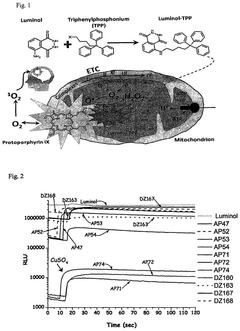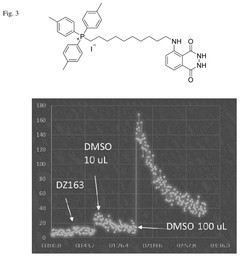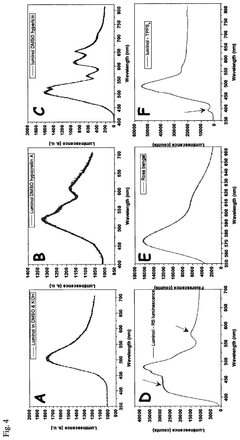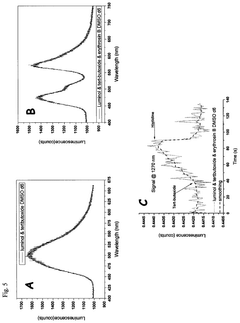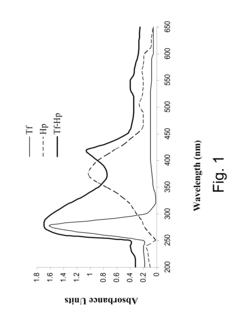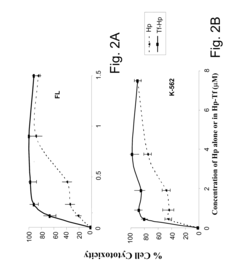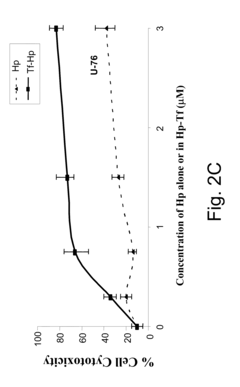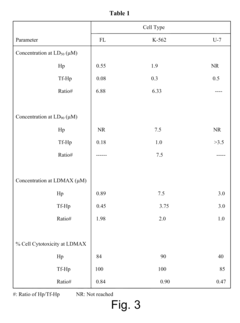How Luminol Drives Efficiency in Biomedical Research?
AUG 19, 20259 MIN READ
Generate Your Research Report Instantly with AI Agent
Patsnap Eureka helps you evaluate technical feasibility & market potential.
Luminol in Biomedical Research: Background and Objectives
Luminol, a chemiluminescent compound, has emerged as a powerful tool in biomedical research, revolutionizing various aspects of scientific investigation. The journey of luminol in this field began in the early 20th century when its light-emitting properties were first discovered. Since then, it has evolved from a curiosity in chemical laboratories to an indispensable reagent in modern biomedical research.
The primary objective of utilizing luminol in biomedical research is to enhance the efficiency and sensitivity of detection methods. This compound's unique ability to produce light when oxidized has made it invaluable in a wide range of applications, from forensic science to molecular biology. In biomedical contexts, luminol has become particularly crucial in techniques such as Western blotting, immunoassays, and the detection of trace amounts of blood.
The evolution of luminol's use in biomedical research has been marked by continuous improvements in its formulation and application methods. Early applications were limited by the compound's relatively low sensitivity and the need for specialized equipment. However, advancements in chemical synthesis and detection technologies have significantly expanded its utility, allowing for more precise and quantitative measurements in biological systems.
One of the key drivers behind luminol's growing importance in biomedical research is the increasing demand for highly sensitive and specific detection methods. As researchers delve deeper into the complexities of cellular and molecular processes, the need for tools that can detect minute quantities of biological molecules has become paramount. Luminol's chemiluminescent properties address this need by providing a means to visualize and quantify biological targets with exceptional sensitivity.
The technical goals associated with luminol in biomedical research are multifaceted. They include enhancing the compound's light-emitting efficiency, improving its stability in various biological environments, and developing novel applications that leverage its unique properties. Researchers are also focused on optimizing luminol-based detection systems to achieve lower detection limits, broader dynamic ranges, and greater specificity in complex biological samples.
As the field of biomedical research continues to advance, the role of luminol is expected to expand further. Emerging trends indicate a growing interest in developing luminol derivatives with enhanced properties, such as longer emission wavelengths or increased quantum yields. These developments aim to push the boundaries of what is possible in biomedical imaging and detection, potentially opening new avenues for diagnosing diseases, monitoring biological processes, and advancing our understanding of fundamental life sciences.
The primary objective of utilizing luminol in biomedical research is to enhance the efficiency and sensitivity of detection methods. This compound's unique ability to produce light when oxidized has made it invaluable in a wide range of applications, from forensic science to molecular biology. In biomedical contexts, luminol has become particularly crucial in techniques such as Western blotting, immunoassays, and the detection of trace amounts of blood.
The evolution of luminol's use in biomedical research has been marked by continuous improvements in its formulation and application methods. Early applications were limited by the compound's relatively low sensitivity and the need for specialized equipment. However, advancements in chemical synthesis and detection technologies have significantly expanded its utility, allowing for more precise and quantitative measurements in biological systems.
One of the key drivers behind luminol's growing importance in biomedical research is the increasing demand for highly sensitive and specific detection methods. As researchers delve deeper into the complexities of cellular and molecular processes, the need for tools that can detect minute quantities of biological molecules has become paramount. Luminol's chemiluminescent properties address this need by providing a means to visualize and quantify biological targets with exceptional sensitivity.
The technical goals associated with luminol in biomedical research are multifaceted. They include enhancing the compound's light-emitting efficiency, improving its stability in various biological environments, and developing novel applications that leverage its unique properties. Researchers are also focused on optimizing luminol-based detection systems to achieve lower detection limits, broader dynamic ranges, and greater specificity in complex biological samples.
As the field of biomedical research continues to advance, the role of luminol is expected to expand further. Emerging trends indicate a growing interest in developing luminol derivatives with enhanced properties, such as longer emission wavelengths or increased quantum yields. These developments aim to push the boundaries of what is possible in biomedical imaging and detection, potentially opening new avenues for diagnosing diseases, monitoring biological processes, and advancing our understanding of fundamental life sciences.
Market Demand for Luminol-Based Techniques
The market demand for luminol-based techniques in biomedical research has been steadily growing, driven by the increasing need for efficient and sensitive detection methods in various fields. Luminol, a chemiluminescent compound, has found widespread applications in forensic science, clinical diagnostics, and molecular biology research due to its ability to produce a bright blue light when oxidized.
In the forensic science sector, luminol-based techniques have become indispensable for crime scene investigations, particularly in detecting trace amounts of blood. The growing emphasis on evidence-based criminal justice systems has led to a surge in demand for luminol-based products and services. Law enforcement agencies and forensic laboratories worldwide are increasingly adopting these techniques to enhance their investigative capabilities.
The clinical diagnostics market has also witnessed a significant uptake of luminol-based assays. These techniques are extensively used in immunoassays, DNA hybridization assays, and enzyme activity measurements. The rising prevalence of chronic diseases and the need for early and accurate diagnosis have fueled the demand for sensitive and specific diagnostic tools. Luminol-based chemiluminescence assays offer advantages such as high sensitivity, wide dynamic range, and rapid results, making them attractive for clinical laboratories.
In the realm of molecular biology research, luminol and its derivatives play a crucial role in Western blotting, a fundamental technique for protein detection and quantification. The increasing focus on proteomics research and the study of protein-protein interactions have further boosted the demand for luminol-based reagents and kits. Biotechnology and pharmaceutical companies engaged in drug discovery and development processes rely heavily on these techniques for target validation and lead optimization.
The global market for luminol and related chemiluminescent reagents is projected to experience substantial growth in the coming years. Factors such as technological advancements in detection systems, the development of novel luminol derivatives with enhanced properties, and the expansion of research activities in emerging economies contribute to this positive outlook. Additionally, the integration of luminol-based techniques with automation and high-throughput screening platforms is expected to open up new avenues for market growth.
However, challenges such as the availability of alternative detection methods and concerns regarding the stability of luminol reagents under certain conditions may impact market growth. Manufacturers and researchers are actively addressing these issues through continuous innovation and product improvements. The development of stabilized luminol formulations and the exploration of new applications in areas such as environmental monitoring and food safety testing are likely to create additional market opportunities.
In the forensic science sector, luminol-based techniques have become indispensable for crime scene investigations, particularly in detecting trace amounts of blood. The growing emphasis on evidence-based criminal justice systems has led to a surge in demand for luminol-based products and services. Law enforcement agencies and forensic laboratories worldwide are increasingly adopting these techniques to enhance their investigative capabilities.
The clinical diagnostics market has also witnessed a significant uptake of luminol-based assays. These techniques are extensively used in immunoassays, DNA hybridization assays, and enzyme activity measurements. The rising prevalence of chronic diseases and the need for early and accurate diagnosis have fueled the demand for sensitive and specific diagnostic tools. Luminol-based chemiluminescence assays offer advantages such as high sensitivity, wide dynamic range, and rapid results, making them attractive for clinical laboratories.
In the realm of molecular biology research, luminol and its derivatives play a crucial role in Western blotting, a fundamental technique for protein detection and quantification. The increasing focus on proteomics research and the study of protein-protein interactions have further boosted the demand for luminol-based reagents and kits. Biotechnology and pharmaceutical companies engaged in drug discovery and development processes rely heavily on these techniques for target validation and lead optimization.
The global market for luminol and related chemiluminescent reagents is projected to experience substantial growth in the coming years. Factors such as technological advancements in detection systems, the development of novel luminol derivatives with enhanced properties, and the expansion of research activities in emerging economies contribute to this positive outlook. Additionally, the integration of luminol-based techniques with automation and high-throughput screening platforms is expected to open up new avenues for market growth.
However, challenges such as the availability of alternative detection methods and concerns regarding the stability of luminol reagents under certain conditions may impact market growth. Manufacturers and researchers are actively addressing these issues through continuous innovation and product improvements. The development of stabilized luminol formulations and the exploration of new applications in areas such as environmental monitoring and food safety testing are likely to create additional market opportunities.
Current State and Challenges in Luminol Applications
Luminol, a chemiluminescent compound, has become an indispensable tool in biomedical research, offering significant advantages in various applications. However, its current state of use and implementation faces several challenges that require addressing to fully harness its potential.
The widespread adoption of luminol in biomedical research has led to remarkable advancements in areas such as forensic science, immunoassays, and cellular imaging. Its ability to produce light when oxidized has made it particularly useful in detecting trace amounts of blood and other biological materials. In forensic applications, luminol has revolutionized crime scene investigations by enabling the visualization of blood traces that are otherwise invisible to the naked eye.
In the realm of immunoassays, luminol-based chemiluminescence has greatly enhanced the sensitivity and specificity of diagnostic tests. This has resulted in more accurate and reliable detection of various biomarkers, pathogens, and other molecules of interest. The non-invasive nature of luminol-based techniques has also made them invaluable in studying cellular processes in living organisms.
Despite these advancements, several challenges persist in the application of luminol in biomedical research. One significant issue is the potential for false positives, particularly in forensic applications. Certain substances, such as bleach and some plant materials, can also trigger luminol reactions, leading to misinterpretation of results. This necessitates the development of more specific detection methods and protocols to minimize false positives.
Another challenge lies in the stability and longevity of luminol solutions. The compound's sensitivity to light and temperature can affect its performance and shelf life, requiring careful handling and storage. This limitation can impact the reliability of results, especially in field applications where controlled environments may not be available.
The sensitivity of luminol-based assays, while generally high, still faces limitations in detecting extremely low concentrations of target molecules. Enhancing the signal-to-noise ratio and developing more sensitive detection systems remain active areas of research. Additionally, the need for specialized equipment and trained personnel to interpret luminol-based results can limit its accessibility in resource-constrained settings.
Environmental and safety concerns also pose challenges in luminol applications. The use of hydrogen peroxide as an oxidizing agent in luminol reactions raises safety considerations, particularly in large-scale or frequent use scenarios. Developing safer alternatives or optimizing reaction conditions to minimize potential hazards is an ongoing area of investigation.
Lastly, the integration of luminol-based techniques with other emerging technologies, such as microfluidics and nanotechnology, presents both opportunities and challenges. While these combinations offer the potential for enhanced sensitivity and automation, they also require overcoming technical hurdles in terms of compatibility and scalability.
The widespread adoption of luminol in biomedical research has led to remarkable advancements in areas such as forensic science, immunoassays, and cellular imaging. Its ability to produce light when oxidized has made it particularly useful in detecting trace amounts of blood and other biological materials. In forensic applications, luminol has revolutionized crime scene investigations by enabling the visualization of blood traces that are otherwise invisible to the naked eye.
In the realm of immunoassays, luminol-based chemiluminescence has greatly enhanced the sensitivity and specificity of diagnostic tests. This has resulted in more accurate and reliable detection of various biomarkers, pathogens, and other molecules of interest. The non-invasive nature of luminol-based techniques has also made them invaluable in studying cellular processes in living organisms.
Despite these advancements, several challenges persist in the application of luminol in biomedical research. One significant issue is the potential for false positives, particularly in forensic applications. Certain substances, such as bleach and some plant materials, can also trigger luminol reactions, leading to misinterpretation of results. This necessitates the development of more specific detection methods and protocols to minimize false positives.
Another challenge lies in the stability and longevity of luminol solutions. The compound's sensitivity to light and temperature can affect its performance and shelf life, requiring careful handling and storage. This limitation can impact the reliability of results, especially in field applications where controlled environments may not be available.
The sensitivity of luminol-based assays, while generally high, still faces limitations in detecting extremely low concentrations of target molecules. Enhancing the signal-to-noise ratio and developing more sensitive detection systems remain active areas of research. Additionally, the need for specialized equipment and trained personnel to interpret luminol-based results can limit its accessibility in resource-constrained settings.
Environmental and safety concerns also pose challenges in luminol applications. The use of hydrogen peroxide as an oxidizing agent in luminol reactions raises safety considerations, particularly in large-scale or frequent use scenarios. Developing safer alternatives or optimizing reaction conditions to minimize potential hazards is an ongoing area of investigation.
Lastly, the integration of luminol-based techniques with other emerging technologies, such as microfluidics and nanotechnology, presents both opportunities and challenges. While these combinations offer the potential for enhanced sensitivity and automation, they also require overcoming technical hurdles in terms of compatibility and scalability.
Existing Luminol-Based Detection Methods
01 Enhancing luminol chemiluminescence efficiency
Various methods are employed to enhance the efficiency of luminol chemiluminescence. These include optimizing reaction conditions, using catalysts, and incorporating additives that amplify the light emission. Researchers focus on improving the sensitivity and intensity of the luminol reaction for applications in forensic science, analytical chemistry, and biosensing.- Enhancing luminol chemiluminescence efficiency: Various methods are employed to enhance the efficiency of luminol chemiluminescence. These include optimizing reaction conditions, using catalysts, and incorporating additives that amplify the light emission. Researchers focus on improving the sensitivity and intensity of the luminol reaction for applications in forensic science, analytical chemistry, and biosensing.
- Novel luminol derivatives and analogs: Development of new luminol derivatives and analogs aims to improve chemiluminescence efficiency. These modified compounds often exhibit enhanced quantum yield, longer emission times, or better stability. Structural modifications can also lead to shifts in emission wavelength or improved solubility, expanding the range of potential applications.
- Luminol-based detection systems: Advanced detection systems utilizing luminol chemiluminescence are designed for various analytical and diagnostic purposes. These systems often integrate microfluidic devices, nanoparticles, or specialized sensors to achieve higher sensitivity and specificity. Applications include environmental monitoring, medical diagnostics, and forensic analysis.
- Luminol reaction catalysts and enhancers: Research focuses on identifying and developing catalysts and enhancers that improve luminol chemiluminescence efficiency. These include metal ions, enzymes, and nanoparticles that can accelerate the reaction rate or increase light output. The selection of appropriate catalysts is crucial for optimizing the performance of luminol-based assays.
- Luminol formulations for specific applications: Specialized luminol formulations are developed for specific applications such as crime scene investigation, biomedical imaging, and industrial quality control. These formulations often combine luminol with other reagents, buffers, or stabilizers to optimize performance under particular conditions or for detecting specific analytes.
02 Novel luminol derivatives and formulations
Development of new luminol derivatives and formulations aims to improve the overall efficiency of the chemiluminescent reaction. These modifications can enhance stability, increase light output, or provide specific targeting capabilities. Researchers explore structural changes to the luminol molecule and create optimized mixtures for various applications.Expand Specific Solutions03 Luminol-based detection systems
Advanced detection systems utilizing luminol chemiluminescence are designed for increased sensitivity and specificity. These systems often incorporate innovative technologies such as microfluidics, nanoparticles, or electrochemical methods to enhance the efficiency of luminol-based detection. Applications range from environmental monitoring to medical diagnostics.Expand Specific Solutions04 Luminol reaction catalysts and enhancers
Research focuses on identifying and developing catalysts and enhancers that improve the efficiency of the luminol reaction. These additives can increase the reaction rate, prolong the emission time, or amplify the light intensity. Metal complexes, enzymes, and nanoparticles are among the materials studied for their catalytic effects on luminol chemiluminescence.Expand Specific Solutions05 Instrumentation for luminol efficiency measurement
Specialized instruments and techniques are developed to accurately measure and quantify luminol efficiency. These may include high-sensitivity photomultiplier tubes, advanced spectrophotometers, or integrated analytical systems. Improved instrumentation allows for more precise evaluation of luminol performance and optimization of reaction conditions.Expand Specific Solutions
Key Players in Luminol Research and Development
The biomedical research landscape for luminol-driven efficiency is in a growth phase, with increasing market size and technological advancements. The competitive field includes academic institutions like Shandong University and Washington University in St. Louis, as well as industry players such as Sanofi and FUJIFILM Corp. These organizations are at various stages of technology maturity, from basic research to commercial applications. The market is characterized by a mix of established pharmaceutical companies and emerging biotech firms, indicating a dynamic and evolving competitive environment. As the technology progresses, we can expect to see more collaborations between academia and industry to drive innovation and practical applications in biomedical research.
Consejo Superior de Investigaciones Científicas
Technical Solution: The Spanish National Research Council (CSIC) has made notable contributions to luminol-based research in biomedicine. Their scientists have developed novel luminol derivatives with improved stability and quantum yield for enhanced chemiluminescence detection. These compounds have been applied in highly sensitive immunoassays for detecting biomarkers of various diseases[9]. CSIC researchers have also pioneered the use of luminol chemiluminescence in flow-injection analysis systems, enabling rapid and automated detection of pharmaceutical residues in environmental samples[10]. Additionally, they have explored the potential of luminol-based assays for monitoring food quality and safety, particularly in detecting adulterants and contaminants in dairy products[11].
Strengths: Diverse applications from clinical diagnostics to environmental monitoring, expertise in chemical synthesis and analytical techniques. Weaknesses: Some technologies may require specialized equipment, potential competition from alternative detection methods.
Sanofi
Technical Solution: Sanofi, a global pharmaceutical company, has incorporated luminol-based technologies into their drug discovery and development processes. They have developed high-throughput screening platforms utilizing luminol chemiluminescence for identifying potential drug candidates. These systems allow for rapid assessment of compound libraries against specific molecular targets[12]. Sanofi has also applied luminol-based assays in their pharmacokinetic and toxicology studies, enabling sensitive detection of drug metabolites and biomarkers of drug-induced toxicity[13]. Furthermore, the company has explored the use of luminol chemiluminescence in quality control processes for biopharmaceutical production, ensuring the purity and potency of their products[14].
Strengths: Integration of luminol technology across drug development pipeline, large-scale application in pharmaceutical industry. Weaknesses: Proprietary nature of some technologies may limit broader scientific access, potential regulatory challenges for novel assay methods.
Innovations in Luminol Chemistry and Formulations
Method of photodynamic therapy
PatentActiveUS12121581B2
Innovation
- Development of a method using chemiluminescent agents with mitochondrial affinity, specifically modified luminol conjugates, that act as an intracellular light source, activating photosensitizers like PpIX within cancer cells to produce cytotoxic singlet oxygen without the need for external light, allowing targeted treatment of hyperproliferative cells and deep-seated tumors.
Photodynamic therapy using chemiluminescence and a ligand-photosensitiser conjugate
PatentInactiveUS20100297762A1
Innovation
- A method involving a ligand-toxin conjugate (LTC) comprising a photosensitizer like hematoporphyrin conjugated with transferrin, combined with a chemiluminescent agent such as luminol, which activates the photosensitizer intracellularly to produce reactive oxygen species, thereby enhancing target cell destruction without requiring external light.
Safety and Environmental Considerations of Luminol Use
Luminol, while a powerful tool in biomedical research, requires careful consideration of safety and environmental factors. The chemical's oxidizing properties and potential for skin and eye irritation necessitate proper handling protocols. Researchers must wear appropriate personal protective equipment, including gloves, lab coats, and safety goggles, when working with luminol solutions. Adequate ventilation is crucial to prevent inhalation of vapors, particularly during the preparation of stock solutions.
Environmental concerns arise from the disposal of luminol-containing waste. The chemical's persistence in aquatic environments and potential toxicity to marine organisms demand responsible disposal practices. Research facilities should implement proper waste management protocols, including the use of designated chemical waste containers and adherence to local regulations for hazardous material disposal.
The alkaline nature of luminol solutions presents additional safety challenges. Accidental spills or splashes can cause chemical burns, emphasizing the importance of readily accessible eyewash stations and safety showers in laboratory settings. Furthermore, the storage of luminol requires attention to temperature and light exposure to maintain its stability and prevent degradation.
Luminol's interaction with other chemicals in the laboratory environment must be considered. Its reactivity with oxidizing agents and certain metals can lead to unexpected reactions or compromised experimental results. Researchers should be aware of potential cross-contamination issues and implement measures to isolate luminol-based procedures from incompatible substances.
The use of luminol in forensic applications introduces additional safety considerations. Crime scene investigators must balance the need for evidence preservation with personal safety when applying luminol to detect blood traces. Proper training in luminol application techniques and crime scene protocols is essential to minimize contamination risks and ensure accurate results.
As research applications of luminol expand, ongoing assessment of its long-term health effects on laboratory personnel is necessary. While acute toxicity is generally low, chronic exposure studies are limited. Implementing regular health monitoring programs for researchers frequently working with luminol may be prudent to detect any potential cumulative effects.
Advancements in luminol formulations and application methods should prioritize safety and environmental considerations. Development of less hazardous alternatives or encapsulated forms of luminol could mitigate some of the current safety concerns while maintaining its efficacy in biomedical research applications.
Environmental concerns arise from the disposal of luminol-containing waste. The chemical's persistence in aquatic environments and potential toxicity to marine organisms demand responsible disposal practices. Research facilities should implement proper waste management protocols, including the use of designated chemical waste containers and adherence to local regulations for hazardous material disposal.
The alkaline nature of luminol solutions presents additional safety challenges. Accidental spills or splashes can cause chemical burns, emphasizing the importance of readily accessible eyewash stations and safety showers in laboratory settings. Furthermore, the storage of luminol requires attention to temperature and light exposure to maintain its stability and prevent degradation.
Luminol's interaction with other chemicals in the laboratory environment must be considered. Its reactivity with oxidizing agents and certain metals can lead to unexpected reactions or compromised experimental results. Researchers should be aware of potential cross-contamination issues and implement measures to isolate luminol-based procedures from incompatible substances.
The use of luminol in forensic applications introduces additional safety considerations. Crime scene investigators must balance the need for evidence preservation with personal safety when applying luminol to detect blood traces. Proper training in luminol application techniques and crime scene protocols is essential to minimize contamination risks and ensure accurate results.
As research applications of luminol expand, ongoing assessment of its long-term health effects on laboratory personnel is necessary. While acute toxicity is generally low, chronic exposure studies are limited. Implementing regular health monitoring programs for researchers frequently working with luminol may be prudent to detect any potential cumulative effects.
Advancements in luminol formulations and application methods should prioritize safety and environmental considerations. Development of less hazardous alternatives or encapsulated forms of luminol could mitigate some of the current safety concerns while maintaining its efficacy in biomedical research applications.
Luminol in Forensic Science: Crossover Applications
Luminol, a chemiluminescent compound widely used in forensic science for blood detection, has found significant crossover applications in biomedical research. This versatile chemical's ability to produce light when oxidized has opened new avenues for enhancing efficiency and accuracy in various biomedical studies.
In forensic science, luminol has long been employed to detect trace amounts of blood at crime scenes, even after cleaning attempts. This sensitivity and specificity have inspired researchers to adapt luminol-based techniques for biomedical applications. One notable area is the detection of hemoglobin and other iron-containing proteins in biological samples, which has proven valuable in studying various blood disorders and related conditions.
The crossover of luminol from forensics to biomedicine has led to the development of highly sensitive assays for detecting specific proteins and enzymes. These assays often surpass traditional methods in terms of sensitivity and speed, allowing researchers to identify and quantify minute amounts of target molecules in complex biological matrices. This capability has been particularly useful in early disease detection and monitoring treatment efficacy.
Moreover, luminol-based techniques have been adapted for imaging applications in biomedical research. By coupling luminol with specific antibodies or other targeting molecules, researchers can visualize cellular processes and protein interactions in real-time. This approach has provided valuable insights into cell signaling pathways, drug metabolism, and the progression of various diseases.
The efficiency gains driven by luminol in biomedical research are multifaceted. First, the high sensitivity of luminol-based assays allows for the detection of biomarkers at much lower concentrations than traditional methods, enabling earlier diagnosis and more precise monitoring of disease progression. Second, the rapid reaction kinetics of luminol oxidation facilitate high-throughput screening applications, significantly accelerating drug discovery processes and toxicity studies.
Furthermore, the non-invasive nature of luminol-based imaging techniques has reduced the need for more invasive procedures in both research and clinical settings. This not only improves the welfare of research subjects but also allows for longitudinal studies with minimal interference, providing more comprehensive and reliable data over time.
The crossover applications of luminol from forensic science to biomedical research exemplify the potential for interdisciplinary innovation in scientific research. As researchers continue to explore and refine luminol-based techniques, we can expect further advancements in diagnostic capabilities, drug development efficiency, and our understanding of complex biological systems.
In forensic science, luminol has long been employed to detect trace amounts of blood at crime scenes, even after cleaning attempts. This sensitivity and specificity have inspired researchers to adapt luminol-based techniques for biomedical applications. One notable area is the detection of hemoglobin and other iron-containing proteins in biological samples, which has proven valuable in studying various blood disorders and related conditions.
The crossover of luminol from forensics to biomedicine has led to the development of highly sensitive assays for detecting specific proteins and enzymes. These assays often surpass traditional methods in terms of sensitivity and speed, allowing researchers to identify and quantify minute amounts of target molecules in complex biological matrices. This capability has been particularly useful in early disease detection and monitoring treatment efficacy.
Moreover, luminol-based techniques have been adapted for imaging applications in biomedical research. By coupling luminol with specific antibodies or other targeting molecules, researchers can visualize cellular processes and protein interactions in real-time. This approach has provided valuable insights into cell signaling pathways, drug metabolism, and the progression of various diseases.
The efficiency gains driven by luminol in biomedical research are multifaceted. First, the high sensitivity of luminol-based assays allows for the detection of biomarkers at much lower concentrations than traditional methods, enabling earlier diagnosis and more precise monitoring of disease progression. Second, the rapid reaction kinetics of luminol oxidation facilitate high-throughput screening applications, significantly accelerating drug discovery processes and toxicity studies.
Furthermore, the non-invasive nature of luminol-based imaging techniques has reduced the need for more invasive procedures in both research and clinical settings. This not only improves the welfare of research subjects but also allows for longitudinal studies with minimal interference, providing more comprehensive and reliable data over time.
The crossover applications of luminol from forensic science to biomedical research exemplify the potential for interdisciplinary innovation in scientific research. As researchers continue to explore and refine luminol-based techniques, we can expect further advancements in diagnostic capabilities, drug development efficiency, and our understanding of complex biological systems.
Unlock deeper insights with Patsnap Eureka Quick Research — get a full tech report to explore trends and direct your research. Try now!
Generate Your Research Report Instantly with AI Agent
Supercharge your innovation with Patsnap Eureka AI Agent Platform!
